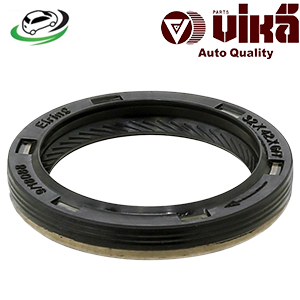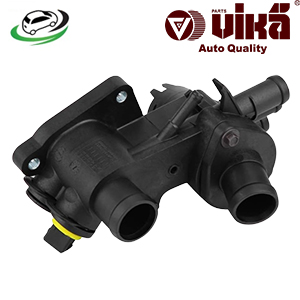-6%
Get Thermostat housing VW Bora I (1J2)/Caddy II MPV/Golf III/Golf IV (1J1)/Golf V (1K1)/Lupo I (6X1/6E1)/Polo (6N2)/ Vento (1H2) 032121111N
The thermostat housing is a crucial component in an engine’s cooling system, designed to house the thermostat and manage the flow of coolant through the engine. Its proper function is essential for maintaining optimal engine temperature, performance, and efficiency. This comprehensive guide explores the thermostat housing’s function, construction, types, benefits, signs of wear, and maintenance in 1000 words.
Function of the Thermostat Housing
The thermostat housing serves several key functions in an engine’s cooling system:
- Holds the Thermostat:
- Location: The thermostat housing encloses the thermostat, a component that regulates the engine’s temperature by controlling the flow of coolant.
- Purpose: By housing the thermostat, the housing ensures that it operates within the designated temperature range, facilitating proper engine warming and cooling.
- Controls Coolant Flow:
- Coolant Pathways: The thermostat housing has passages that direct the flow of coolant between the engine and the radiator. It ensures that coolant circulates efficiently based on the engine’s temperature.
- Prevents Coolant Leaks:
- Sealing: The housing provides a secure seal to prevent coolant from leaking out of the engine. It is typically designed with gaskets or seals to ensure a leak-proof connection.
- Facilitates Engine Warm-Up:
- Temperature Regulation: The thermostat within the housing regulates the engine’s warm-up process by controlling the flow of coolant to the radiator. This helps the engine reach its optimal operating temperature efficiently.
- Ensures Engine Efficiency:
- Optimal Temperature: By managing the coolant flow and maintaining the correct engine temperature, the thermostat housing contributes to overall engine efficiency and performance.
Components of the Thermostat Housing
The thermostat housing consists of several key components that work together to ensure proper function:
- Housing Body:
- Material: Usually made from aluminum, cast iron, or high-strength plastic.
- Function: The main body of the housing encloses the thermostat and provides pathways for coolant flow.
- Thermostat:
- Material: Typically made from metal with a wax or spring mechanism.
- Function: The thermostat regulates coolant flow based on the engine’s temperature. It opens and closes to allow or restrict coolant flow between the engine and the radiator.
- Gasket or O-Ring:
- Material: Made from rubber or silicone.
- Function: Provides a seal between the thermostat housing and the engine to prevent coolant leaks.
- Coolant Passages:
- Design: The housing features passages that direct coolant flow to and from the engine and radiator.
- Function: Ensures that coolant circulates efficiently and reaches the engine and radiator as needed.
- Thermostat Housing Cap:
- Material: Typically made from metal or plastic.
- Function: Covers the opening of the thermostat housing and may include a pressure relief valve to manage coolant pressure.
Types of Thermostat Housing
Thermostat housings come in various designs, each suited to different engine configurations and applications:
- Single Outlet Housing:
- Design: Features a single outlet for coolant flow.
- Application: Common in simpler engine designs where only one coolant path is required.
- Dual Outlet Housing:
- Design: Includes two outlets for coolant flow, often with one for bypass coolant and one for radiator coolant.
- Application: Used in engines with more complex cooling systems, providing separate paths for different coolant flows.
- Integrated Housing:
- Design: Combines the thermostat housing with other engine components, such as water pumps or sensors.
- Application: Found in modern engines with optimized designs to save space and reduce complexity.
- Adjustable Housing:
- Design: Allows for adjustment of the thermostat or coolant flow settings.
- Application: Used in engines requiring variable temperature control or special cooling requirements.
Benefits of a Properly Functioning Thermostat Housing
A well-maintained and properly functioning thermostat housing provides several benefits:
- Optimal Engine Temperature:
- Performance: Ensures that the engine operates at its optimal temperature, improving performance, fuel efficiency, and reducing emissions.
- Prevents Overheating:
- Cooling Efficiency: Helps prevent engine overheating by regulating the flow of coolant and maintaining proper temperature.
- Reduces Engine Wear:
- Longevity: By keeping the engine temperature within the desired range, the thermostat housing helps to reduce wear and tear on engine components.
- Improves Fuel Efficiency:
- Efficiency: A properly functioning thermostat housing ensures that the engine reaches its optimal operating temperature quickly, improving fuel efficiency.
- Maintains Cooling System Integrity:
- Leak Prevention: By providing a secure seal and managing coolant flow, the thermostat housing helps to maintain the integrity of the cooling system.
Signs of a Worn or Failing Thermostat Housing
Over time, the thermostat housing can experience wear or damage due to exposure to heat, pressure, and coolant. Recognizing the signs of a faulty thermostat housing is important for timely maintenance:
- Coolant Leaks:
- Symptom: Visible coolant leaks around the thermostat housing or engine can indicate a damaged gasket or housing.
- Engine Overheating:
- Symptom: Frequent engine overheating or high temperature readings may be caused by a malfunctioning thermostat or housing that fails to regulate coolant flow properly.
- Erratic Temperature Readings:
- Symptom: Fluctuating or inconsistent temperature readings on the engine temperature gauge can indicate issues with the thermostat housing or thermostat.
- Low Coolant Levels:
- Symptom: Consistently low coolant levels may be due to leaks from the thermostat housing or a faulty seal.
- Steam or Smoke from Engine:
- Symptom: Steam or smoke emanating from the engine compartment can be a sign of coolant leakage or overheating, potentially caused by a failing thermostat housing.
Maintenance and Replacement
Regular maintenance and timely replacement of the thermostat housing are crucial for ensuring proper engine function and avoiding potential issues:
- Inspection:
- Routine Checks: Inspect the thermostat housing and its components regularly for signs of wear, damage, or leaks. Ensure that the housing is securely attached and that the gasket or seal is intact.
- Cleaning:
- Maintenance: Clean the thermostat housing and surrounding areas to remove any dirt, debris, or coolant residue that may affect performance or cause leaks.
- Replacement Interval:
- Manufacturer’s Recommendations: Follow the manufacturer’s recommendations for thermostat housing replacement or maintenance intervals. Replacement may be necessary if signs of damage or wear are observed.
- Professional Replacement:
- Expert Installation: If the thermostat housing is damaged or needs replacement, it is recommended to have a professional mechanic perform the replacement to ensure proper installation and sealing.
- Seal and Gasket Replacement:
- Seal Maintenance: Replace the gasket or seal if it is worn or damaged to prevent coolant leaks and ensure a proper seal.
- System Bleeding:
- Coolant System: After replacing the thermostat housing, ensure that the cooling system is properly bled to remove any air pockets and maintain optimal coolant flow.
Follow us on Facebook for more parts.



